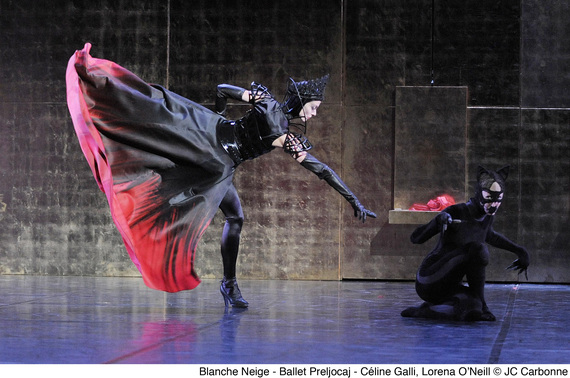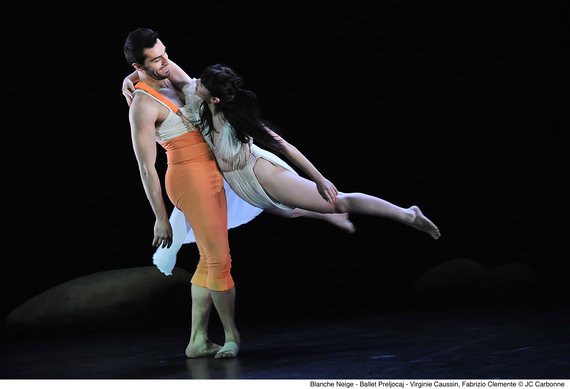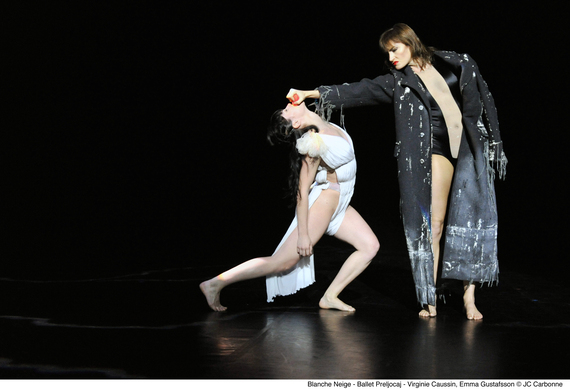
When I heard that Angelin Preljocaj was bringing his high-fashion Snow White to Lincoln Center, I had high hopes. Story ballet is making a comeback, and I was curious to see how the classically trained, but thoroughly contemporary choreographer would treat this popular Grimm's tale.
Also intriguing, Snow White has no real precedent in ballet, so Preljocaj was essentially starting from scratch. Given the story's themes of love, jealousy and obsession with youthful beauty -- so relevant to modern culture, and so conducive to physical expression -- it's easy to understand its appeal to the choreographer.
Throw in costumes by Jean-Paul Gaultier, enchanting sets by Thierry Leproust and Preljocaj's own troupe of 25 superb dancers, and the production had a lot of promising ingredients. Unfortunately, however, it failed to live up to its potential, and despite claims to the contrary, it was actually quite similar to the 1937 Disney version -- just with weirder music and several kinky, R-rated twists.
To be fair, there are several explicit nods to the Brothers Grimm original, which the choreographer credits as his inspiration. The lighting reflects its dark mood (perhaps a bit too closely); the Mahler-meets-electronica score ties the tale's Romantic origins to the present; the prince reveals a necrophilic streak; and in the final wedding scene, the queen is made to dance to death in hot iron shoes.
To the choreographer's credit, he also adds some effective twists of plot, notably the introduction of the prince to Snow at the beginning of the story, when she is alive and well, rather than dead in a glass coffin. This sets the stage for a more believable love story to take shape, much in the same vein as Romeo and Juliet, as well as some exquisite dancing by the story's central lovers.
A far cry from the Miss-Goodie-Two-Shoes of the Disney cartoon, this version's Snow White (Nagisa Shirai) is a barefooted, nubile nymph and perhaps even a bit of a rebel. Clad in a weird, white diaper-dress, its color suggests her virginal purity, but it also suggests her blossoming womanhood by revealing plenty of leg and loin.
Haunches are also prominently featured by Gaultier's costumes for the courtiers, who dance in prurient celebration of the heroine's coming of age. It is in this scene where we first meet the strapping, tangerine-trousered prince (Sergio Diaz), who tosses the giddy princess a red scarf to set their love story in motion.
Three gorgeous duets chart their progression from innocent flirtation, to passionate love, to the anguish of perceived loss. In the main love scene, precarious balances and ecstatic leaps melt into delicious surrender. In the death duet, the prince's machinations with Snow's lifeless body get a bit creepy for my tastes, but his agony is palpable as he spins madly, breast flung open, and then collapses and writhes on the floor.
Charming as these lovers are, though, their story is actually secondary to that of Snow's stepmother, the queen (Anna Tatarova). Like the prince, she also enters in the coming-of-age scene -- naturally to lightning bolts and claps of thunder. Instantly we grasp her cruel and sadistic nature: in a red bustle, black hood, spiky crown, strappy bodice and thigh-high boots, she hurls and kicks curses at the court, trailed by two menacing black cats.
We also quickly get a sense of her vanity: before a huge, gilded mirror, she dances with her reflection, smugly satisfied to be fairest of the land. But when Snow White inevitably supersedes her, the royal dominatrix flies into a jealous rage and hatches her nefarious plot.
No, there is no doubt that this woman is evil -- especially when she shoves the poison apple down poor Snow's throat and drags her around by her head. But S&M twists aside, this is where the ballet lapses into Disney. Unlike Snow and her prince, who are developed into fleshy, emotionally rich characters, the queen -- who is the story's main character -- remains a two-dimensional caricature of vanity, jealousy and hate.
This is where Preljocaj leaves key questions unanswered -- perhaps intentionally, or perhaps because he spent too much time on other sections that were less important to the story. At the opening of the ballet, a long, tedious scene depicts Snow's birth and her mother's immediate death, but nowhere is it explained how her stepmother came onto the scene -- or even suggested that she has a seductive hold on the heroine's father.
A few other protracted scenes -- notably, one depicting the unfortunate, robot-like deer whose heart is cut out in place of Snow's -- indulge a lot of monotonous choreography, but do little to develop the characters or plot.
But even if we suppose that the queen really is just plain, old mean and bitter, it's in some ways hard to blame her. In the fantasy world of this production, there appear to be few virtues outside youth and sex appeal; whatever the charms of this spirited Snow, ultimately she's a threat to the queen because she's young and pretty. Yet at the same time, the queen's unabashed nastiness makes it hard to feel any pity for an aging woman in a youth-obsessed world, so it's not really clear what the message is.
As a fantasy and love story, the Preljocaj Snow White offers some things to admire, including a rich, immersive aesthetic created by the choreography, costumes and sets (the music, however, was often jarring and intrusive). The ballet also shows imaginative prowess -- most memorably the entrance of the seven dwarfs, who, suspended by cords, abseil a stone wall in an otherworldly aerial ballet.
Still, these merits fail to compensate for the opportunity that Preljocaj missed to offer more eloquent and nuanced commentary on beauty, aging and death -- themes that are all very relevant to modern society. While it was refreshing to see the story's heroine portrayed a little "dirtier" than her name suggests, the queen's pure evil belongs to another era -- one that Disney already covered.
